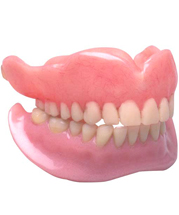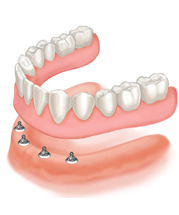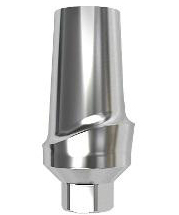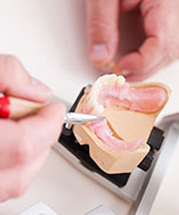LedicoLab is a zirconia milling unit equipped with state-of-the-art devices by Amann Girrbach, making all-ceramic crowns and bridges supported on zirconia oxide substructures, with the use of CAD/CAM technology. Ceramill is a complete zirconia processing system consisting of a scanner, a computer with CAD software for designing substructures, and a milling machine. Perfect bio-compatibility, low thermal conduction and high translucency are its key features. We offer Zirconia works - sub-structures for crowns, bridges, endodontic posts, inlays, onlays and any other works that can be produced with the use of our milling machine.
Send us the saw-cut model of the work, opposing dentitions and occlusion registration and we will scan , design and make the prosthetic work in a colour of your choice.
Zirconia milling
Services offered by the laboratory
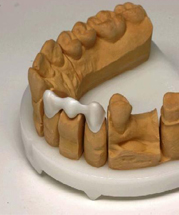
Ceramics and zirconia
Services offered by the laboratory

It has been one of the most popular solutions recently. This type of replacement has no metal structure and is made exclusively from porcelain secured on a zirconia “cap”, therefore it perfectly imitates the colours of natural teeth. What is more, absence of any metal makes this type of crowns perfect for allergic persons, allergic reactions are usually caused by a metal used in substructures of traditional porcelain crowns.
Press method
Services offered by the laboratory
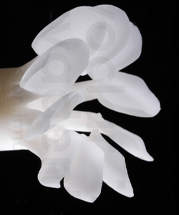
- crowns
- veneers
- onlay, inlay, overlay
- anterior bridges up to 3 units
- build-up pressed to metal or zirconia structure.
The durability of structures made with the use of press method is comparable to that of a tooth’s hard tissue. The minimum thickens of the frame is 0.6 to 0.7 mm. The pressing material can be white (for making crowns and bridges) or have one of 16 colours as per Vita classic shade guide (for making veneers and crowns). The method enables pressing a ceramic margin to porcelain-fused-to-metal or zirconia crowns. The works made with the use of this method are characterised by high fluorescence and opalescence.
Orthodontic appliances
Services offered by the laboratory
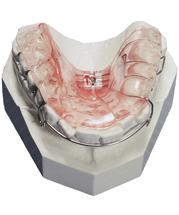
Schwartz appliance
It is the most popular removable appliance. It is made of an acrylic plate, expansion screw, labial arch and clasps for retention. The acrylic plate should be thick enough to ensure stability of wires which are much thinner on the sides and of a much more solid screw. The expansion screw may be placed along the palatine raphe and symmetrically expand the arches or may be placed laterally and asymmetrically for the purpose of distalization, medialization or rotation of a tooth or a group of teeth. The labial arch is a standard element in the Schwartz’s appliance. Naturally, various arches may be used with the Schwartz appliance. It may be a spring, Tiegerstedt’s arch, sliding arch, and modifications thereof. Retention elements, apart from standard clasps, include: Adam’s clasps, Hungarian clasps, ball-end clasps, continuous clasps and prosthetic clasps. Schwartz appliance may also be equipped with springs or tongue guard with bolts.
Lehman Appliance
It consists of a baseplate, central screw or A or B-type three-directional screw placed at the position of 1st premolar, of labial arch, retention clasps and/or caps on upper incisors. Lehman Appliance has lateral bite planes encompassing premolars and molars, including the third molar. Bite planes contain headgear tubes (the size of which is determined by the dentist), placed depending on the area to be treated. Lehman Appliance also has an acrylic shield set in the construction bite, with s-formed springs, supporting the lower incisors.
Castillo-Morales Plate
This acrylic plate with acrylic guard and opening in the palatal section preventing tongue thrusting is used either as a retention or to correct tongue dysfunctions. Apart from the base plate, Castillo-Morales plate also has a guard in the form of a block which can reach as far as the molars. Additional opening in the palatal area, either circular or oval, 1 - 2 cm in diameter, engages the tongue and prevents thrusting. Apart from the labial arch, Castillo-Morales plate is also equipped with Adam's clasps.
Retainer
Retainer is used by patients who completed their therapy with the use of a fixed appliance. Aretainer consist of palatal acrylic plate, an arch and retaining elements (clasps). Due to the absence of a screw, the plate should be very delicate and have minimum range. When designing the plate, the range and shape of the anterior section and the possibility of use of a fixed appliance fitted behind the teeth, should be taken into consideration.
Active retainer
In the anterior section, an active part may be used. The arches may be straight (Van der Linden), they may be springs with limited range, or extended wires reaching as far as the last molars. In more difficult cases, straight arch with acrylic elements may be used. The fixing element are usually Adam’s clasps, but - as in the case of other appliances - also Hungarian clasps, ball-end clasps, arrowhead clasps and prosthetic clasps as well as any modifications of any of these can be used. Depending on the shape and elements incorporated, a retainer weighs between 2 and 5 grams.
Relaxation plate
It is the most varied appliance in terms of construction and use. Relaxation plate may be produced with the use of heat forming technology from materials of varied thickness and hardness; it may be one or two-layer (in the latter case, made of two different materials of different hardness, e.g. soft on the mucus side and hard on the occlusive side). It may be made of acryl with the use of traditional method - it is more solid than (but also thicker), more resistant to grinding and cracking, offering more precise reconstruction of tooth surface.s Acrylic plates are equipped with clasps. Relaxation plates are used to reduce the tension of temporomandibular joints in patients suffering from Bruxism, or as post-surgery treatment, etc.
Bite Raiser
It may be used on upper or lower jaw. Bite raiser consist of lateral bite blocks and anterior straight block. The plate is kept in place usually by means of ball-end clasps, but also other clasps may be used.
Block Appliance
For many years block appliance has been one of the most popular removable block appliances for both jaws. It is made of upper and lower acrylic plate connected in construction bite. The appliance is rather bulk, with a screw fixed centrally along the palatine raphe, with a labial arch and - in its basic form - without clasps. Presently, however, it is more and more frequently used with Adam’s or ball-end clasps. An important feature of the appliance is the choice of movement track correcting occlusion in the lateral buccal part of the acrylic plate. It is either prepared in a lab or by a dentist in their office. In the case of block appliances (as in any other appliances used on both jaws) precise correction bite, particularly as regards lateral relation) is required. Otherwise, as a result of extensive muscle tension, the appliance can break in the palatal area.
Twin Block
It consist of two separate acrylic plates, stabilised in the construction bite by means of acrylic blocks (the lower situated medially and the upper - distally). Oblique block surfaces with pre-set angle of inclination stabilise the anterior-posterior relation of the plates. It is sually retained by means of Adam’s, delta, or ball-end clasps. Additional stabilisation is achieved through delicate separation of cusps of the antagonist teeth. Screws are mounted centrally in lower and upper plate.
Individual abutments Atlantis
Services offered by the laboratory
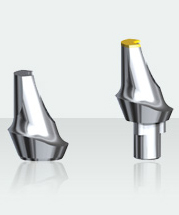
Are you looking for a perfect solution for cemented crowns? Then you are looking for Atlantis™. By introducing unique software Atlantis VAD™ (Virtual Abutment Design) the abutments are now tailor-made to fit the ultimate shape of teeth. The result is an extremely functional abutment presenting great aesthetic values.
Atlantis™ is a true gem and we are happy to share it with you.
- outstanding functionality and aesthetics - the most natural reconstruction you can expect
- Simple prosthetics procedure means shorter chair time - all you need is to take the impression and send it to the lab
- There is no need to buy abutments in advance
- Abutments independent of the prosthetic platform and made of materials you prefer
Freedom. Try out the unlimited range of cemented implantoprosthetic reconstructions
Atlantis™ abutments available as titanium, gold-shaded titanium and zirconia are compatible with the majority of existing implant systems.
Aesthetics As every abutment is tailor-made to fit the final tooth shape, the optimum operational and functional effects can be achieved. Every abutment is specially designed to ensure accurate anatomy and suitability for the place it is to be fixed in.
Simplicity. All you need to do is take the impression and send it to the prosthetic lab without wasting your time for searching the right abutment and ordering other components. With Atlantis abutments you don’t need to make any modifications in your office and are able to adjust the implant position - the inclination angle, depth, and rotation.
Atlantis™ Zirconia abutment is perfect for anterior teeth - particularly challenging for aesthetic reasons - and, at the same time, durable enough to be used also in lateral sections.
Atlantis™ titanium abutment is suitable for all positions in the oral cavity.
Atlantis GoldHue™ abutment is made of gold-shaded titanium. Natural look of the reconstruction is achieved due to the biocompatible thin coating of titanium nitride (TiN) that gives a warm and aesthetic gold-shaded tone under the gingiva. It is suitable for all positions in the oral cavity.
Atlantis™ abutments are individually designed and made, taking into account not only the actual space available but also the relations with other abutments, which is particularly important when the whole tooth arch or several units are being restored.





